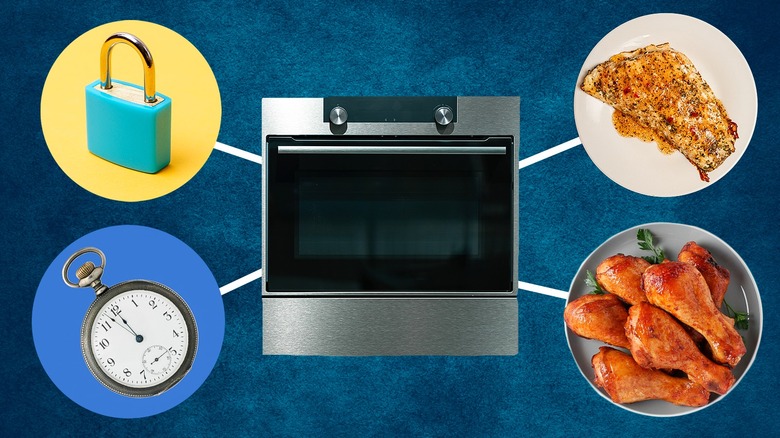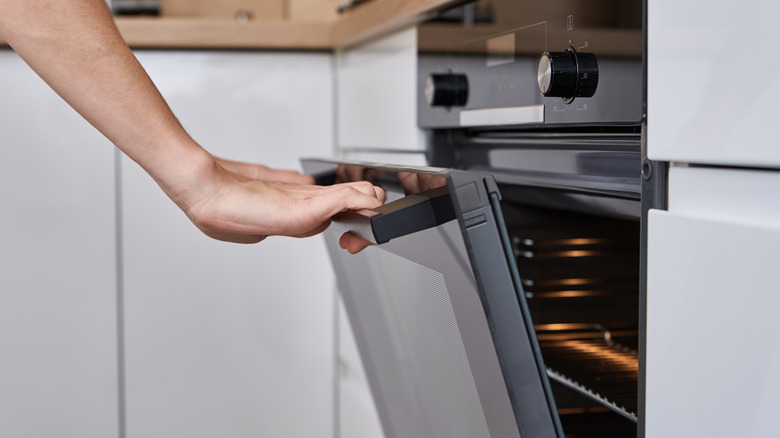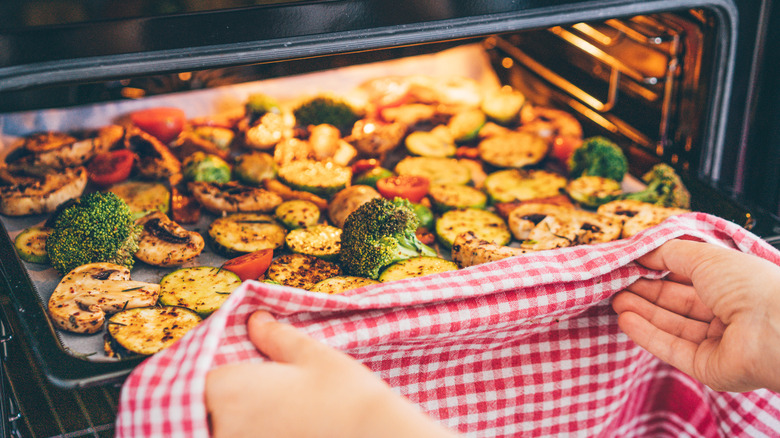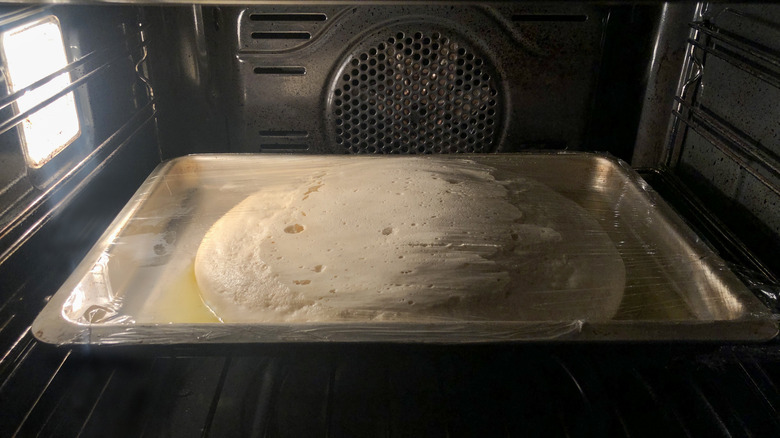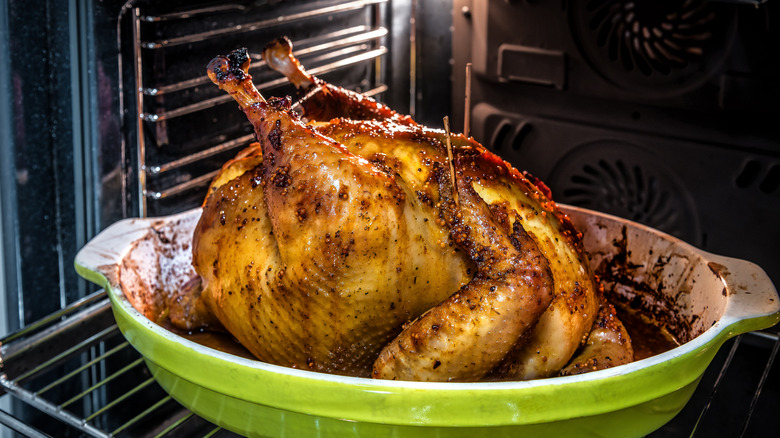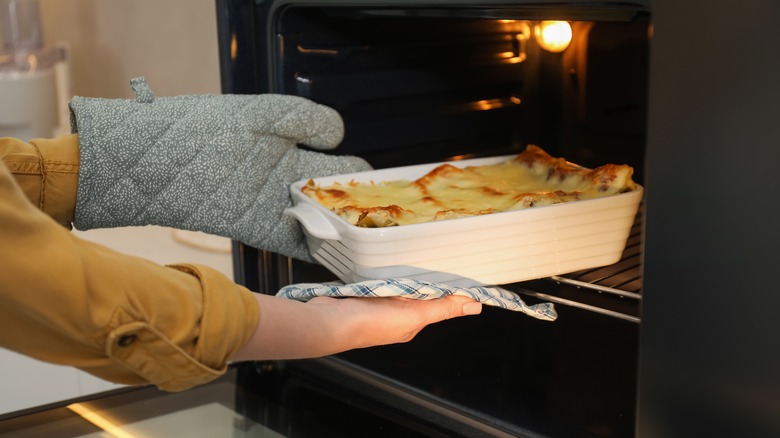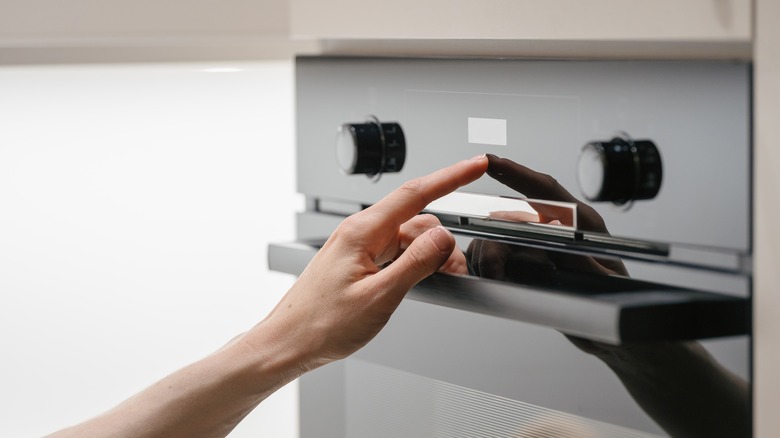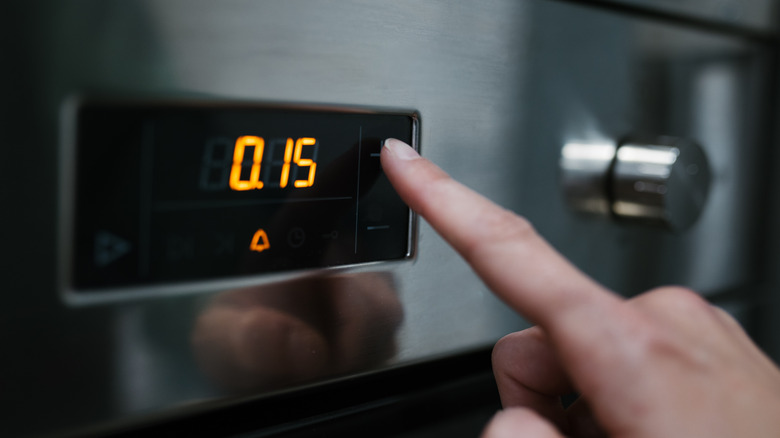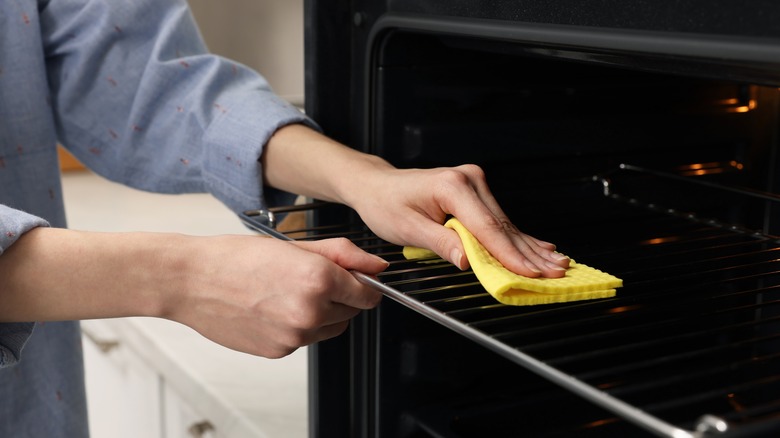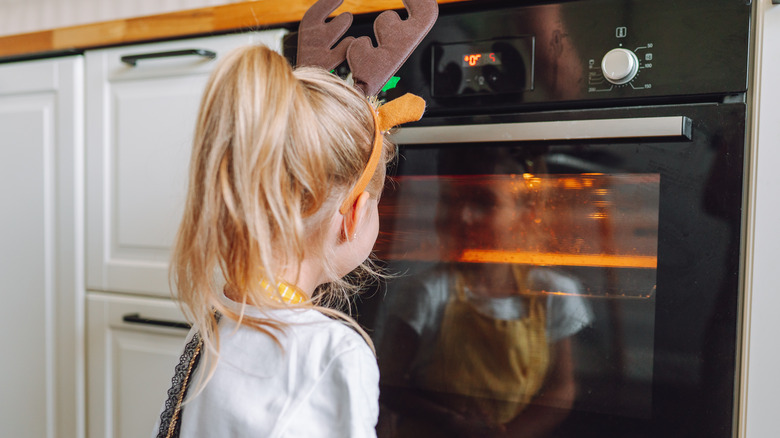10 Oven Functions You're Probably Not Using (But Totally Should)
If you're like many, you probably use your oven for a range of cooking and baking recipes. These may include birthday cakes, beef or pork roasts, barbecue chicken, your grandma's famous baked macaroni and cheese, and countless others. It's great that your oven can help you do all of these things. But, what if we told you that you might be missing out on using it to its full potential? What if you discovered that many of your go-to recipes could come out tasting even better than they already do and that there are actually other ways to use your oven that you might not have even known about?
There are lots of buttons on an oven. Many people use only a few of these to turn the oven on and adjust the temperature. However, if you experiment with some of these other functions, you'll wonder how you ever survived without them. Not only will you be able to cook various recipes to perfection, but you'll also be able to better manage other necessities, including the timing of your meal, tackling the dreaded task of cleaning the oven, and making sure any children in the home stay safe.
Convection
Many ovens today offer a convection setting. Because many people don't understand the difference between a convection oven and a standard one or know the best times to use their oven's convection setting, they often ignore this feature. However, there are many reasons to educate yourself and start taking advantage of all that the convection setting has to offer. A traditional oven features heating elements that slowly warm up the rest of the air in the oven. Convection ovens — or your oven when using the convection setting — utilize a special fan to distribute the hot air throughout the oven.
Because of this improved air circulation, the preheating time for a convection oven is typically less than that of a standard one. But, where you'll really notice the benefits of this setting is in the way your foods turn out. With the fan circulating the air more, you'll find that foods cook more evenly. While the bottom rack of a traditional oven may cook faster because it is closer to the heating element, you shouldn't notice such a disparity when using the convection setting. Moreover, because the convection setting allows the oven to get warmer, you might also notice that your foods cook a bit quicker than they do without using it.
There's one other important benefit to highlight as well. Because the hot air is constantly circulating around the cavity of the oven because of the fan, the foods you cook will also turn out crispier than they would otherwise. This is due to the fact that they won't retain as much excess moisture on their exterior with the air constantly moving around them.
Roast
Which setting did you use the last time you cooked a beef or pork roast or a tray of brussel sprouts or cubed red potatoes? Did you simply do what you always do and hit the bake button to get the oven up to the desired temperature? If so, it is time to give the roast setting on your oven a test drive. The roast setting is designed to be used when cooking foods at a higher temperature than you would use when baking most dishes. These higher temperatures are typically ideal to use when you want the outside of an item — such as that beef roast or those Brussels sprouts — to be crispier than the inside.
If your oven has convection capabilities, it may also have a special convection roast feature. Like a standard roast setting, this is an excellent choice when you're preparing large cuts of meat or hearty vegetables. The main difference between the convection roast and standard roast settings is the air circulation. As with other convection settings, opting for a convection roast setting means that the fan will help ensure that the air is circulating through the oven more evenly. This can result in even crispier and more nicely browned skin or exteriors. You might consider it if you're roasting a whole chicken and want the skin to be extra crispy or if you really want the outside of your potato wedges to have a crunch while the insides are still nice and creamy.
Broil
The broil setting is another one that you'll want to start using when preparing certain dishes. Broiling is a technique that involves cooking — or searing — food with intense heat from above. With the broil setting of your oven, you'll be doing just that. Selecting this option warms up the upper heating element to a very high temperature, typically over 500 degrees Fahrenheit. You'll typically want to move one of the oven racks up to move the item you're preparing directly under the heating element. The intense, direct heat means that foods will be cooked in a similar fashion to how they are on a grill.
While you can use the broil feature to cook an item from start to finish — typically a thinner cut of meat or another smaller item — it is also commonly called for when finishing a recipe. For example, if you're making lasagna and want the cheese on the top layer to get a bit crispy, turn to the broil setting. After the lasagna in the baking pan has heated all the way through, move the rack up, and turn on the broiler. It should only take a few minutes for that gooey upper layer of cheese to crisp up. Just remember that because you're dealing with such intense heat, whatever you're broiling can go from nice and crispy to burnt in no time. You always want to keep a close eye on the progress of your meal to avoid such a catastrophe.
You might also want to try broiling vegetables. However, understanding when to roast vs broil vegetables is key. While broiling is likely best for thinner and more delicate veggies, such as tomatoes, the longer cooking time for roasting will be ideal for heartier and thicker options, such as potatoes or cauliflower.
Proof
If you've been wondering whether it is possible to proof bread in the oven, you might just be in luck if your oven has a special proof setting. Ovens with this setting are designed to provide the optimal environment needed for yeast to be activated and help bread, cinnamon rolls, and other pastries rise properly. If you're familiar with baking, then you know these optimal conditions include warmth and moisture.
So, when you select the proof setting on your oven, you're helping expose your baked goods to consistent levels of humidity and warmth. Many people try to proof dough in a standard oven. And, while it is possible, you're taking more of a gamble because the temperature doesn't always stay consistent and there may be more changes in the humidity levels as well. Beyond the consistency that a proof setting offers, it also simplifies the overall process of making homemade treats. Many people are scared off from trying a recipe that calls for proofing dough simply because they don't know whether they'll be able to do it properly. With the proof setting, you can gain more confidence to experiment with that homemade cinnamon roll recipe you've always wanted to try.
Air fry
Whether you're someone who still hasn't added one of the best air fryers to your collection of small appliances or you're someone who uses your air fryer on a daily basis, you could benefit from the air fry setting on your oven. As you can probably guess, this setting is designed to mimic the cooking results and benefits that you get when using a standalone air fryer. This means that the foods you prepare should turn out perfectly crispy on the outside and ready to enjoy. You can achieve crunchy "fried" foods without the need for much (or any) oil.
So, just what is the air fry setting on an oven, and how is it different from other baking settings? Well, the primary difference once again is that convection fan that keeps air circulating through the cavity throughout the entire cook time. With the hot air passing over items as they cook, the skin and edges are able to crisp up beautifully. To make the most of the air fryer setting on your oven, consider purchasing an air fryer basket that has more open sides. This design will help ensure that the circulating air is able to hit all sides of the foods you're cooking, just as it would if you were using a smaller countertop air fryer. With the large capacity of your oven, you can double or even triple your favorite easy air fryer recipes to serve even more people.
Keep warm
Getting your timing right for every meal isn't easy. If you've ever had one dish cook faster than you were anticipating, then you know the frustration. You don't want to serve your guests in stages, but you also don't want half of their plate to be lukewarm. If your oven has a keep warm or warm setting, then instances such as these are the perfect time to put it to use. The keep warm feature can also come in handy if you're serving dinner but one of your guests will be arriving late. It can ensure that they'll still get a hot meal, even if everyone else has already finished eating.
Unlike baking, roasting, or broiling modes, which all use high temperatures of 350 degrees Fahrenheit or more, the keep warm setting heats the oven to a much lower temperature (typically under 200 degrees Fahrenheit). At this temperature, your food items will stay warm. However, unlike if you were to leave them in a much hotter oven, they also won't continue cooking. This means that they should retain their moisture and avoid getting dried or over-cooked.
When using the keep warm feature, there are a few things to keep in mind. First, the food you're putting in the oven must be cooked all the way through. The lower temperatures are not high enough to finish cooking something, so you could be risking food poisoning if you make such an assumption. You must also be careful to avoid a common mistake when using the warming setting: using non-oven-safe cookware or dishes. Even though you're heating the oven to a much lower temperature than you would use for baking or roasting, you don't want to risk damaging anything dishes that are not oven-safe.
Delay start
If you haven't tried out the delay start function on your oven (if it has one), then you've been missing out. The feature does precisely what it sounds like: delays the time that the oven will start, or begin heating up. There are many ways in which the delay start feature can simplify your life. Have you ever planned to make something for dinner and had all the other parts of the meal ready only to realize that you forgot to preheat the oven? Well, with the delay start feature, you could set the oven to turn on automatically earlier in the day when you start thinking about your meal.
Similarly, you shouldn't overlook the delay start feature's ability to help you get dinner to the table if you're not able to be right by the appliance to get it going when desired. If you work from home, for example, and have a call you need to be on from 5:00 to 6:00, let the delay feature help you. Put your assembled dish in the oven before your call, set it to turn on at the time you want, and when you emerge from your home office, dinner will be ready to enjoy.
Before you start experimenting with the delay start feature, there are a few safety considerations to keep in mind. You shouldn't set the oven to turn on at a time when no one is home — this is a fire hazard. You also should be careful with how long you leave perishable items in the oven before starting it. Meats, dairy products, and anything else that is perishable should not be left out at room temperature for more than an hour (two hours max) to avoid letting bacteria grow.
Cook time
The cook time setting is another one that can help make sure your meals turn out properly without adding any unnecessary stress to your already full plate. With this function, you can tell the oven to cook whatever food you have in it for the desired amount of time before turning off on its own. This can be a real life-saver when you're busy dealing with other things and don't want to inadvertently burn or overcook whatever is in the oven.
Some ovens that have both delay start and cook time features may even allow you to use both functions together. This means that you could set your oven to turn on at the desired time, cook your food for a set amount of time, and then shut off on its own once the meal is finished. Talk about hands-off cooking. All you need to do is get the food in the oven and press a few buttons.
Steam cleaning
You may be familiar with the self-clean setting found on many ovens, especially older models. Ovens with this feature heat to temperatures so high that it burns off foods and grease that are stuck to the cavity. While it can be nice to not have to scrub vigorously to release all the gunk, the self-clean cycle has a lot of negatives — including how it makes your home smell during the process and the charred mess you're left to deal with once it concludes.
If you have a newer oven, it may have a steam clean setting. It's understandable if you've overlooked this function or assumed that it is simply another name for the standard high-heat self-cleaning cycle. However, a steam cleaning cycle is something completely different, which many users greatly prefer over older cleaning options. With it, the oven warms up to cause plain water to heat up and release steam. As the steam is released, it loosens the gunk on the walls much more gently, yet still effectively. A steam clean cycle is generally shorter than a self-cleaning one. Plus, because the oven doesn't get as hot, it also cools down more quickly so you can wipe it out and move on to everything else you need to accomplish.
Child lock
While you might want to start teaching your kids some easy and safe cooking skills, you certainly don't want them turning on the oven or adjusting the temperature on their own. Fortunately, some ovens are designed with a child lock safety feature that can prevent them from being able to operate it. While the specifics of this feature may vary slightly between models, the idea is the same. You turn on the child lock using the control panel (often by pressing and holding the button for it).
Once activated, the settings on the oven can not be adjusted. It will not respond if anyone tries to turn it on, increase the temperature, or change the cooking mode. If you want to adjust anything, you'll need to turn the lock back off, at least temporarily, to do so. No more worrying about your toddler creating a safety hazard or ruining dinner by changing the temperature or turning off the oven as it is cooking.
